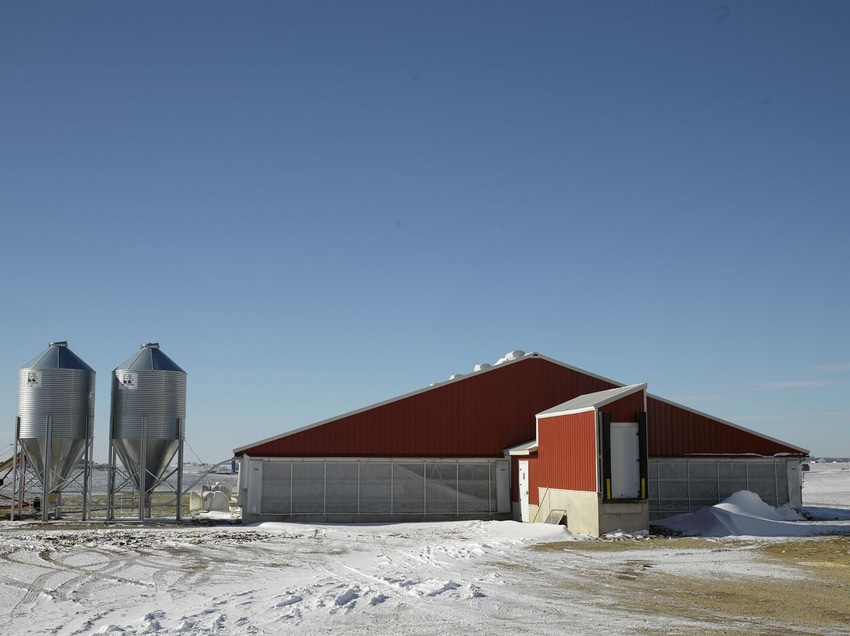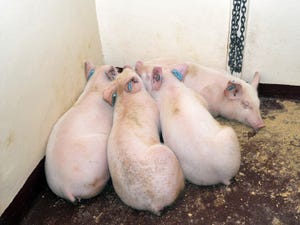Addressing biocontainment of PRRS Lineage 1C 1-4-4
UMN exploratory study examines whether PRRS RNA can be detected on surfaces, such as exterior doorknobs, anteroom floors and exhaust fans.

While porcine reproductive and respiratory syndrome virus can be transmitted between pigs indirectly through fomites or airborne transmission, the indirect route has not been well characterized, says Marcello Melini, a research assistant with the University of Minnesota College of Veterinary Medicine.
After the PRRS Lineage 1C 1-4-4 strain emerged in late 2020, impacting several breeding and grow-to-finish herds with high mortality in Minnesota and then throughout the Midwest, Melini says the strain's fast dissemination and ability to evade robust biosecurity measures led the industry to question some of those indirect routes of transmission once again.
"Is this new variant more infectious? Do pigs shed more virus allowing it to get out of the farm easily? Does it survive more time on surfaces?" says Melini.
To determine whether PRRS RNA can be detected on surfaces outside of positive farms as a proxy of dissemination, an exploratory study funded by the University of Minnesota Swine Disease Eradication Center was conducted with eight selected farms (three breeding and five growing pig farms) in a high dense area. One of the farms was PRRS negative but located in a high dense region and surrounded by positive farms, this farm was used as the negative control. All of the other farms were undergoing a PRRS Lineage 1C 1-4-4 outbreak or were being stocked with positive pigs at the time of the study.
The sampling protocol included wiping of specific areas and surfaces and was developed in conjunction with swine practitioners. A surface sampling protocol previously validated for the PRRS virus and influenza was used.
Using clean gloves, sterile cloths moistened with 20 ml of PBS were used to sample a 1ft-by-1ft area. Once the sample was collected, the cloth was deposited in a sterile plastic bag and fluid was extracted and poured into Corning Falcon tubes (Fisher scientific), labeled according to sampled surface and farm. Samples were then refrigerated and submitted for PRRS virus RT-PCR testing at the University of Minnesota Veterinary Diagnostic Laboratory.
Sample areas included the main entrance doorknob, the entrance floor, the ante-room floor, loading chutes, mortality doorknob, the mortality sled and exhaust fan cones.
Out of 169 environmental samples collected at the eight farms, 19 (13.28%) samples from seven farms yielded at least one positive RT-PCR result. Two samples for viral isolation yielded a negative result.
Eight (42%) of the positive samples originated from exhaust fan cones in four farms with a Ct value (i.e. the lower the Ct value, the higher the number of viral particles detected in the sample) ranging from 30.29 to 35.98. Main door entry doorknobs in four farms tested positive in four occasions with Ct values ranging between 31.68 and 36.35. The remaining positive samples originated from surfaces such as ante-room floors and mortality carts with Ct values ranging from 25.41 to 35.38.
With most of the positive samples originating from exhaust fan cones, Melini says that was to be expected as the virus was likely becoming airborne and exiting the barn.
While the detection of viral genetic material on surfaces on the outer areas of a farm housing PRRSv positive pigs is possible using a targeted surface sampling, Melini says more studies are needed in this area. Although detection was low in this study, the concentration of viral RNA in samples can be significant. Future research should also include more farms, collect more samples (and during different times of the year) and compare different strains.
However, this exploratory study did illustrate the need for biocontainment as exterior doorknobs and the floor on the dirty side of benches were contaminated.
"We can detect viral genetic material on surfaces, but mostly target surfaces. So maybe when we address a farm for some biosecurity protocols, we can focus on these areas that are high risk and maybe you see compliance for this being done," Melini says. "Again, we need to address biocontainment. Are we doing enough to hold the virus inside of the farm and not putting it through to other farms?"
About the Author(s)
You May Also Like





